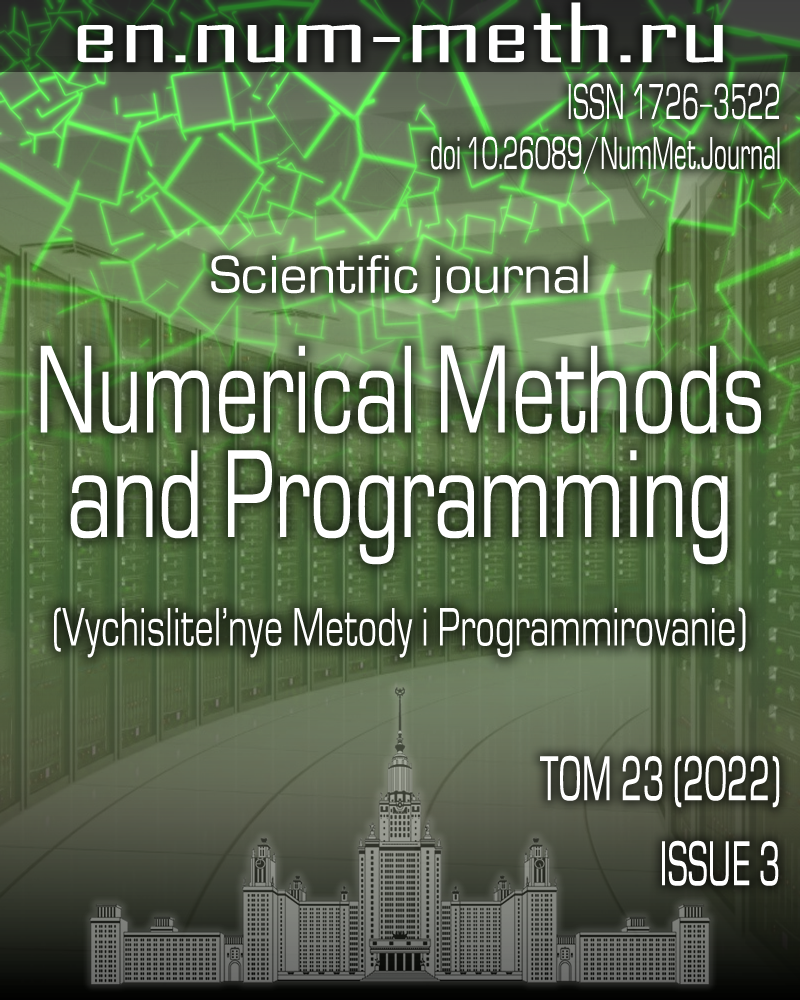DOI: https://doi.org/10.26089/NumMet.v23r314
Selecting the most informative set of the deep-ocean tsunami sensors based on the r-solution method
Keywords:
Abstract
A significant constituent element of tsunami forecasting is to gain some insight into an initial tsunami waveform (below referred to as a tsunami source). Representing a tsunami source as a solution to the inverse problem of mathematical physics based on the inversion of remote records of the incoming wave allows one in detail to study the factors affected the inversion results. The above issue is an ill-posed one that causes the expected instability of the numerical solution. The regularization based on the truncated singular value decomposition (SVD) method (below referred to as the r-solution method) allows one to avoid this obstacle. Within the method proposed, we offer the methodology for selecting the most informative set of the tsunami sensors for the case of the Solomon Islands Tsunami of February 6, 2013, as an example. The method can be used in designing a tsunami warning system.
Published
Issue
Section
References
- I. E. Mulia, A. R. Gusman, and K. Satake, “Optimal Design for Placements of Tsunami Observing Systems to Accurately Characterize the Inducing Earthquake,” Geophys. Res. Lett. 44 (24), 106-115 (2017).
doi 10.1002/2017GL075791. - M. J. Hossen, P. R. Cummins, and K. Satake, “Complete Implementation of the Green’s Function Based Time Reverse Imaging and Sensitivity Analysis of Reversed Time Tsunami Source Inversion,” Geophys. Res. Lett. 44 (19), 9844-9855 (2017).
doi 10.1002/2017GL074528. - J. Meza, P. A. Catalán, and H. Tsushima, “A Methodology for Optimal Designing of Monitoring Sensor Networks for Tsunami Inversion,” Nat. Hazards Earth Syst. Sci. Discuss. (2018).
doi 10.5194/nhess-2018-269. - C. An, P. L.-F. Liu, and L. Meng, “A Sensitivity Analysis of Tsunami Inversions on the Number of Stations,” Geophys. J. Int. 214 (2), 1313-1323 (2018).
doi 10.1093/gji/ggy212. - E. Lee, T. Jung, J.-C. Kim, and S. Shin, “A Study of the Optimal Deployment of Tsunami Observation Instruments in Korea,” J. Ocean Eng. Technol. 33 (6), 607-614 (2019).
doi 10.26748/KSOE.2019.100. - L. Zhao, F. Yu, J. Hou, et al., “The Role of Tsunami Buoy Played in Tsunami Warning and Its Application in South China Sea,” Theor. Appl. Mech. Lett. 3 (3) (2013).
doi 10.1063/2.1303202. - K. Satake, “Inversion of Tsunami Waveforms for the Estimation of a Fault Heterogeneity: Method and Numerical Experiments,” J. Phys. Earth 35 (3), 241-254 (1987).
doi 10.4294/jpe1952.35.241. - C. Pires and P. M. A. Miranda, “Tsunami Waveform Inversion by Adjoint Methods,” J. Geophys. Res.: Oceans 106 (C9), 19773-19796 (2001).
doi 10.1029/2000JC000334. - D. B. Percival, D. W. Denbo, M. C. Eblé, et al., “Extraction of Tsunami Source Coefficients via Inversion of DART^circledR Buoy Data,” Nat. Hazards 58 (1), 567-590 (2011).
doi 10.1007/s11069-010-9688-1. - M. J. Hossen, A. Gusman, K. Satake, and P. R. Cummins, “An Adjoint Sensitivity Method Applied to Time Reverse Imaging of Tsunami Source for the 2009 Samoa Earthquake,” Geophys. Res. Lett. 45 (2), 627-636 (2018).
doi 10.1002/2017GL076031. - I. E. Mulia, A. R. Gusman, M. J. Hossen, and K. Satake, “Adaptive Tsunami Source Inversion Using Optimizations and the Reciprocity Principle,” J. Geophys. Res.: Solid Earth 123 (12), 10749-10760 (2018).
doi 10.1029/2018JB016439. - V. V. Voronin, T. A. Voronina, and V. A. Tcheverda, “Inversion Method for Initial Tsunami Waveform Reconstruction,” Nat. Hazards Earth Syst. Sci. 15 (6), 1251-1263 (2015).
doi 10.5194/nhess-15-1251-2015. - T. A. Voronina and A. A. Romanenko, “The New Method of Tsunami Source Reconstruction with r-Solution Inversion Method,” Pure Appl. Geophys. 173 (12), 4089-4099 (2016).
doi 10.1007/s00024-016-1286-z. - T. A. Voronina, V. V. Voronin, and V. A. Cheverda, “The 2015 Illapel Tsunami Source Recovery by Inversion of DART Tsunami Waveforms Using the R-Solution Method,” Pure Appl. Geophys. 176 (7), 2985-2993 (2019).
doi 10.1007/s00024-019-02100-y. - T. A. Voronina and V. V. Voronin, “A Study of Implementation Features of the r-Solution Method for Tsunami Source Recovery in the Case of the Illapel Tsunami 2015,” Pure Appl. Geophys. 178 (12), 4853-4863 (2021).
doi 10.1007/s00024-021-02843-7. - T. A. Voronina, “Recovering a Tsunami Source and Designing an Observational System Based on an r-Solution Method,” Numer. Anal. Appl. 9 (4), 267-276 (2016).
doi 10.1134/S1995423916040017. - T. A. Voronina and A. V. Loskutov, “Applying the R-Solution Method for Designing a Tsunami Observational System,” J. Phys.: Conf. Ser. 2099 (2021).
doi 10.1088/1742-6596/2099/1/012063. - NOAA Center for Tsunami Research. Solomon Islands Tsunami, February 6, 2013.
https://nctr.pmel.noaa.gov/solomon20130206/images/publish/f20130206_energyS5.png . Cited August 31, 2022.
License
Copyright (c) 2022 Т. А. Воронина, В. В. Воронин

This work is licensed under a Creative Commons Attribution 4.0 International License.


